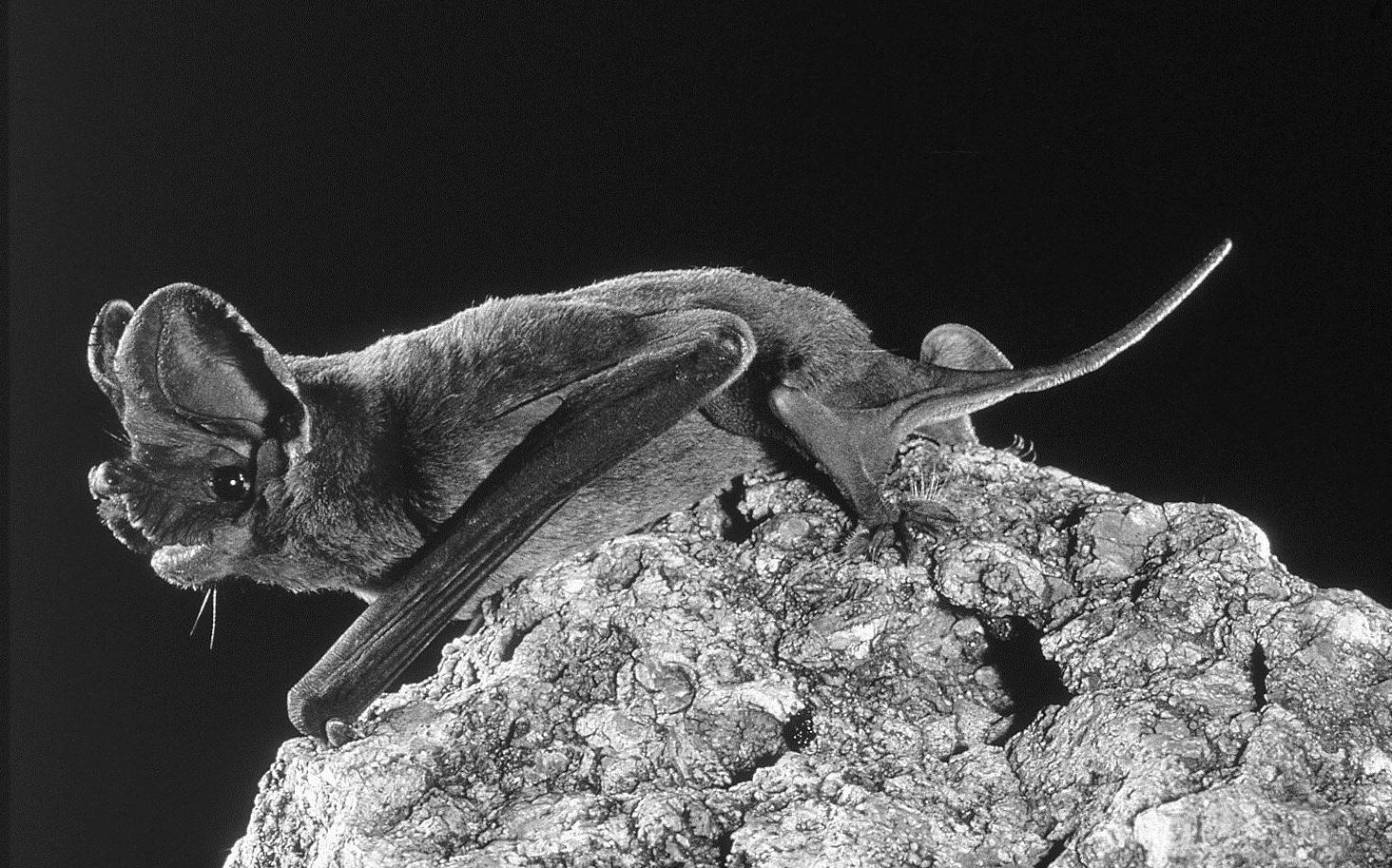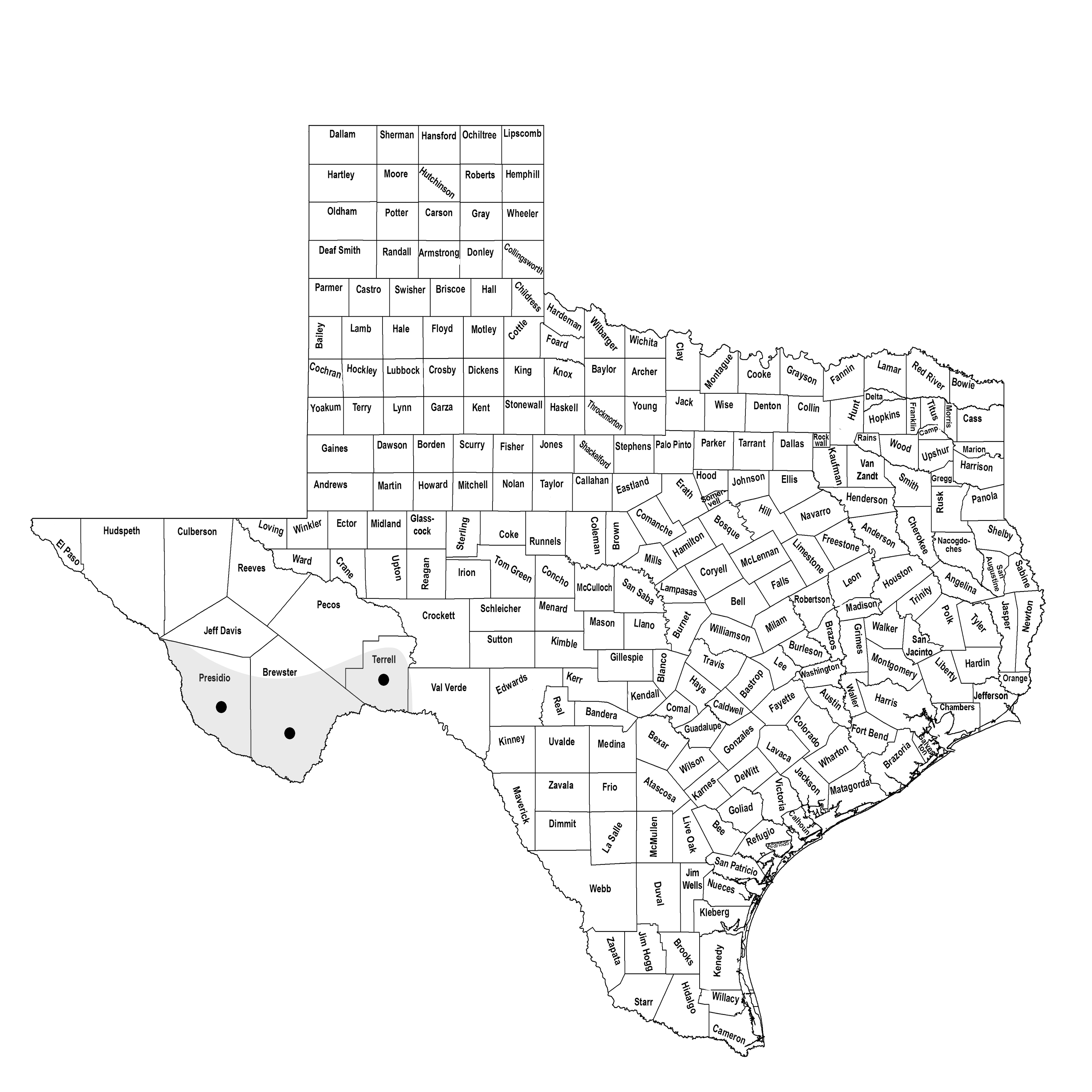POCKETED FREE-TAILED BAT
Nyctinomops femorosaccus (Merriam 1884)
Order Chiroptera : Family Molossidae
DESCRIPTION. Similar to the Brazilian free-tailed bat, Tadarida brasiliensis, but the bases of the ears are joined at the midline; second phalanx of the fourth digit <5 mm; anterior part of hard palate narrowly, rather than broadly, excised; upper incisors placed close together, their longitudinal axes nearly parallel, not convergent, distally. A fold of skin stretching from the inner (medial) side of the femur to the middle of the tibia produces a shallow pocket on the underside of the interfemoral membrane in the vicinity of the knee, a structure to which the common name alludes. Dental formula: I 1/2, C 1/1, Pm 2/2, M 3/3 × 2 = 30. Averages for external measurements: total length, 112 mm; tail, 46 mm; foot, 10 mm; ear, 23 mm; forearm, 46 mm. Weight, 10–14 g.

DISTRIBUTION. This bat is found throughout the Mexican Plateau. The northern edge of its range extends into southern California, New Mexico, Arizona, and West Texas. This bat was first recorded in Texas from Big Bend National Park in 1967. Since that time additional specimens from Brewster County as well as Presidio and Terrell counties have been recorded. The specimens from Terrell County along the Rio Grande represent the easternmost record of this species. It has been documented as far north as Carlsbad Caverns in southern New Mexico.

SUBSPECIES. Monotypic species.
HABITS. This species is an inhabitant of semiarid desert lands. It has been found using day roosts in caves and crevices in cliffs and under the roof tiles of buildings. Studies conducted since its initial discovery in Big Bend have revealed that this bat is a well-established, year-round resident of the area.
As an inhabitant of semiarid desert lands, this species roosts in caves and rock crevices of rugged canyon country, although it has also been reported in buildings. It is a colonial rooster, and colonies generally are thought to be small and contain fewer than 100 individuals. Limited evidence suggests that males and females roost together.
These bats leave their day roost late in the evening to forage, exhibiting swift, powerful flight. In 1955, Philip Krutzsch recorded the following observations made at a colony of 50–60 of these bats he found at a daytime roost in a crevice in the face of a cliff in San Diego County, California, on 17 March.
The first bats left the colony at 6:15 p.m.; others followed in twos and threes for another half hour. The bats dropped from 1 to 1.5 m (3–5 ft.) before taking wing. Their flight appeared to be a rapid, complete wing beat. When first taking flight, they uttered a shrill, sharp, high-pitched, chattering call, which was repeated while the bats were in full flight. They also squeaked a great deal while in the roost. He described the odor of this bat as similar to that of the Brazilian free-tailed bat but not quite so strong.
This rapid-flying bat pursues insects on the wing. The stomachs of 13 bats captured in Big Bend National Park were found to contain moths, crickets, flying ants, stinkbugs, froghoppers and leafhoppers, lacewings, and unidentified insects. Data on reproduction in this species are scarce, but females give birth to a single young between late June and early July. Pregnant bats, each containing a single embryo, have been captured from 10 June to 12 July in Big Bend National Park, and lactating females from 20 June to 17 August. Volant juveniles have been captured from 29 August to 27 November.
POPULATION STATUS. Common, year-round resident. Although formerly thought to be rare throughout its range in both the United States and Mexico, recent studies suggest that, even though the pocketed free-tailed bat is restricted in distribution in Texas, it can be locally common. In a recent survey of bats in the Big Bend by Higginbotham and Ammerman of Angelo State University, 5 out of 17 sites surveyed included this species, which was second in abundance only to Tadarida brasiliensis, with N. femorosaccus accounting for 13% of the total bat captures.
CONSERVATION STATUS. The pocketed free-tailed bat's status is listed by the IUCN as least concern in view of its wide distribution, presumed large population in some localities, and occurrence in a number of protected areas. It does not appear on federal or state lists of concerned species. Although it is not widely distributed in Texas, no direct threats to its survival or population size are apparent.
From The Mammals of Texas, Seventh Edition by David J. Schmidly and Robert D. Bradley, copyright © 1994, 2004, 2016. Courtesy of the University of Texas Press.
Natural Science Research Laboratory
-
Address
Museum of Texas Tech University, 3301 4th street, Lubbock, TX 79409 -
Phone
806.742.2486 -
Email
nsrl.museum@ttu.edu

